Rapture of THE DEEP; Jacqueline Bisset's famous wet t-shirt as film marketing strategy; how it happened and where it was filmed.
In 1977, when a forbidden photo of Jacqueline Bisset scuba diving in a white t-shirt was released to the public, it transformed the potential reach of promotional messaging throughout the film industry. Allegedly snapped by a National Geographic photographer, the photo evoked the ancient Venus Genetrix and ignited controversy as opening day for "The Deep" approached. With Bisset's consent never obtained, and the photo published without her knowledge despite an agreement that she controlled what pictures of her were released, the marketing for the film sharply accelerated as the buzz around the photo controversy went viral. This was the birth of a film marketing revolution, where the line between reality and fiction blurred, and movie marketing was forever changed.
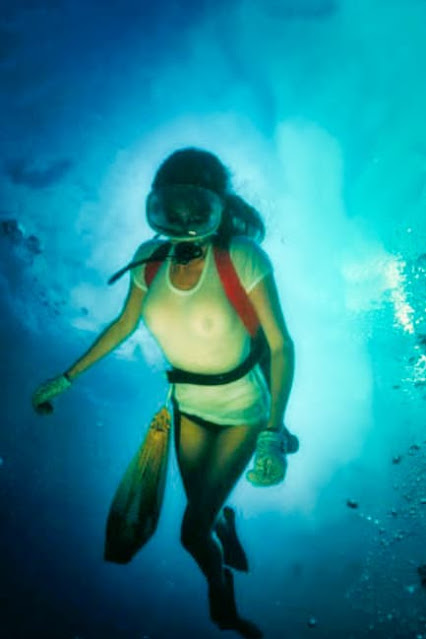 |
| Jacqueline Bisset pioneers viral marketing in film (Source unknown possibly David Doubilet) |
The Deep's potential commercial partners were promised a massive reach ahead of its opening day on June 17, 1977. The film's marketing campaign was a year in the making, with a target to make sure "everyone in America" had read, seen, or heard about the movie at least 15 times before its release. The goal was to create a cultural phenomenon and make The Deep a must-see for action movie fans everywhere.
 |
| "THE DEEP campaign began a year ago" |
 |
| "The Total Saturation ... now Casablanca surfaces with the soundtrack" |
The mystery photographer behind the iconic scuba diving shot of Jacqueline Bisset in "The Deep" has never been revealed... until now. National Geographic's legendary lensman, David Doubilet, was on set capturing the movie's epic opening scenes at the wreck of RMS Rhone in the British Virgin Islands.
As the tension beneath the waves reached its peak Bisset's character, Gail Berke, came out of the water and climbed aboard a sleek Mako 23 Inboard named Sunkiss. Manufactured by promotional partner Mako Boats, the vessel was moored at South West Breaker, Bermuda, a famous dive site approximately 2.5 kilometres (1.7 miles) south west of Bermuda's Church Bay, on South Road.
South West Breaker is one of Bermuda's ultimate diving destinations, with crystal clear waters, stunning visibility and a diverse array of sea creatures. The summit of the reef can be seen behind Bisset as she climbed into Sunkiss.
 |
| Waves crash against South West Breaker, Bermuda, behind Jacqueline Bisset in 1976 (Source Sony Pictures). |
Underwater Earth provides a magnificent Street View swim beneath the prehistoric coral reef where Bisset created film marketing history.
Although the entire story takes place in Bermuda, this scene began with Bisset's character thrashing above the thrilling wreck of RMS Rhone in the British Virgin Islands. Rhone played the part of the fictitious Bermuda wreck Goliath and, as Bisset and Nick Nolte surfaced, the filming location cut to South West Breaker where the underwater world merged with Bermuda to become a breathtaking backdrop to the story.
 |
| Nick Nolte, Jacqueline Bisset and cinematographer Al Giddings, with his "Ferrari red" Petermar camera system, between takes on the Mako 23 at South West Breaker, Bermuda, 1976 (Source Sony Pictures) |
The iconic and translucent photo of Jacqueline Bisset became a legendary moment in film history, sparking controversy and skyrocketing The Deep to the forefront of moviegoer's minds. But was it part of a calculated marketing plan or simply a chance moment captured on film? Bisset's powerful performance as Gail Berke coupled with her smouldering and alluring underwater appearance, made The Deep a must-see action movie for fans around the world. Despite Bisset's objections to the unauthorised release of the photo, her captivating presence built excitement and eager anticipation for the film's release. However, Bisset was upset that the unauthorised photos distracted from the hard work that went in creating the film. Casablanca Records co-founder Larry Harris's decision to promote the film by organising "wet T-shirt contests around the country” suggest that Bisset's concerns were wholly justified (Harris, 2018).
 |
| (Source unknown possibly David Doubilet) |
Bisset's recollection of events has remained reliably consistent even decades after the event. In 1983, only six years after The Deep's release, Bisset replied “no” when asked by Joan Rivers if she decided to take the shot. Bisset continued, “… and I think nobody noticed what was going on until they looked at the rushes really … they said just put the t-shirt on and go diving and then they, you know, they looked at the film.”
 |
| "No, nobody did. Nobody paid, nobody made any remark about if for three weeks and then they looked at the rushes and said ..." (Source YouTube) |
Rivers responded, “And nobody had any idea it was going to look like that?”. Bisset replied, “… No, nobody did. Nobody paid - nobody made any remark about if for three weeks and then they looked at the rushes …”
In the 21st century, Bisset's recollection remains reliable, “Somebody said to me, ‘This is what they wear.’(Hoffman, 2018) "I did what the designer [Ron Talsky] told me to do" (Parker, 2015). "I had no sense of what I looked like at all.” (Hoffman, 2018). "I thought, “Okay. Well, we’re underwater. Big deal. You won’t see anything underwater.” (Parker, 2015).
 |
| (Source Sony Pictures) |
Bisset was aware that the t-shirt was translucent after diving. "When we came out of the water, there was always somebody there with a dressing gown, a robe, to put around me so that this would not happen, and I felt pretty secure." (Parker, 2015).
 |
| Bisset in her robe over white t-shirt chats with stunt double Jackie Kilbride (Source Sony Pictures) |
"There were a couple of scenes where we came out of the water at the boat, and there was a wet t-shirt look, but it was not focused on at all." (Parker, 2015)
 |
| "David, I panicked" (Source Sony Pictures) |
With film developing taking place in New York and dailies only arriving after a long journey back to the production base at Peter Island Yacht Club, the exquisite imagery reportedly caught everyone by surprise. Producer Peter Guber claimed that the "lovely and sensual sight" of Bisset in a "clinging white t-shirt" was a surprise that appeared in the early rushes from RMS Rhone.
 |
| Nick Nolte, Jacqueline Bisset, Robert Shaw and director Peter Yates outside the administration office at Peter Island Yacht Club, 1976, now Peter Island Resort. |
Bisset recalls "The first weeks of shooting, nobody had any rushes" (Parker, 2015) and it appears she never got to see them after they arrived. "I hadn’t seen the film, but I was getting very little feedback from that level and thought it was all in hand." (Parker, 2015).
But at some point those who had seen the rushes decided to increase the amount of Bisset's performance as Gail Berke and reduce the performance of stunt double Jackie Kilbride, "... they said we looked so different underwater that they wanted me to do a lot more than I bargained for." (Parker, 2015)
When interviewed a few months after the film's release Jackie Kilbride said that she needed to wear a padded bra under her white t-shirt "to come up to Jackie's [Bisset] topside dimensions".
 |
| Stunt double Jackie Kilbride with Stan Waterman discusses filming while dressed as Gail Berke in white t-shirt (Source Sony Pictures). |
The Deep author Peter Benchley said he had no idea who decided to put Jacqueline Bisset in a 'wet t-shirt' but suggested it was either producer Peter Guber or director Peter Yates. In an interview published the day after the film opened (18 June 1977) Peter Yates confirmed that Bisset was consulted on which pictures would be published, "Jackie had the right to ok all her stills and they had decided to take out ads in all magazines, varying the photo for each magazine. The ones that ended up in Playboy and Penthouse were not the ones she had chosen."(The Atlanta Journal and Constitution, 1977).
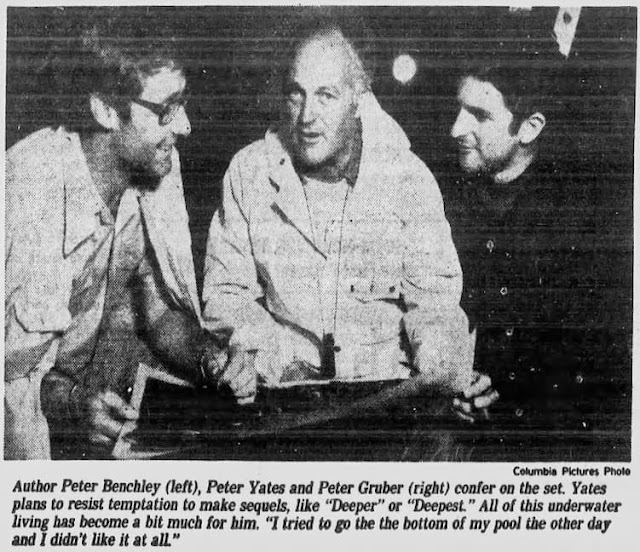 |
| Photo supplied by Columbia Pictures that appeared in The Atlanta Journal and Constitution story. |
"Twas not the flimsiness of the garment that bothered Jackie["], said Yates. "She felt that picture looked like she was posing. She has passed on two photos that had her in a t-shirt, but she did want to make it look as if she were posing for some nudie shots." (The Atlanta Journal and Constitution, 1977). As Yates' last sentence contradicts the first, on the entire point of consent, then it seems he either misspoke or Thomas' quote of Yates, saying that Bisset did want to " make it look as if she were posing for some nudie shots", is a typo that likely intended to say "she did not".
 |
| Producer Peter Guber (left), Nick Nolte (centre), director Peter Yates (right) on location. |
Bisset indicates she never saw the dailies; "I don’t know for sure, but I believe the photos that were taken of me and then used, were taken by the National Geographic photographer" (Parker, 2015). David Doubilet was the only credited underwater still photographer from National Geographic
Paul Tzimoulis, husband of expert diver and The Deep's underwater continuity crew member Geri Murphy, captured Doubilet in action as he snapped away at Bisset during filming on the Rhone (below). Tzimoulis' photo of Doubilet accompanied an article teasing the film, that appeared in the May 1977 issue of Skin Diver Magazine , the month before the film was released.
 |
| Paul Tzimoulis' captures David Doubilet (far right) photographing Jacqueline Bisset for Skin Diver Magazine, May 1977. |
When Bisset finally did see herself, she says, “I thought I was going to die!” (Hoffman, 2018). "I felt betrayed because it’s all people talked about and it had nothing to do with the work we put into the film" (Lampert, 2019).
Peter Yates echoed the loss of focus on the film's achievements, "It's unfortunate that we put out so much information on a film and that's what every-one focuses on," (The Atlanta Journal and Constitution, 1977). Some of that information revealed many technical firsts in filmmaking including:
 |
| Stan Waterman, Al Giddings and Chuck Nicklin with Giddings' Petermar camera system that filmed Bisset underwater. |
Both Peter Benchley and underwater cameraman Chuck Nicklin believed that Bisset felt "exploited" a word she has not used herself when interviewed. Bisset says she was "upset, very upset" ... "I thought it had nothing to do with the film. I had a really dangerous time underwater at times during filming. I’d almost drowned at one point" (Parker, 2015) a fact she reiterated in 2019 when asked to share stories behind her favourite career photos. However, in a 2022 interview with Peter Hammond, Bisset agreed that she was very disappointed with what had happened "... and it happened on another film where I got exploited, massively exploited." "The Deep was a different one," she continued, "because we were the most wonderful group of people. Everybody was really working hard and we'd, it hadn't really been done before to do this sort of story underwater. It was very dangerous and to have it summed up for me as a wet t-shirt thing was not great."
 |
| "What I remember most is almost dying" said Bisset when seeing this photo (Source Sony Pictures) |
Bisset was referring to an incident in which she and Nolte both lost their air supply while filming Gail Berke's escape above RMS Rhone. As Bisset kicked furiously toward Sunkiss above, Nolte's regulator separated from its mouthpiece leaving him facing certain death. He recalled, “I was 50 feet down and the mouthpiece on my breathing apparatus broke off. I spit it out and grabbed the tube and tried to take a breath and I got nothing but salt water. I couldn't see a thing and I swam into the camera. The cameraman stayed with the action, probably saying to himself 'The guy's really drowning and I'm getting it on film!’ Fortunately, six guys turned up with breathing hoses.” (Edwards, 1976). Nolte's frantic search for air was caught on multiple cameras as he ripped off his mask, swam toward the camera crew and urgently made the diver hand-signal for needing air.
 |
| Nolte kicks for the crew and taps his mouth after his mouthpiece shatters "I need to share air" (Source Sony Pictures) |
"What I remember most is almost dying." continued Bisset, "I was deep underwater with Nick Nolte, and there were so many bubbles I couldn’t find my mouthpiece to breathe. Luckily the cinematographer realised I was in trouble and shared his with me. I thought I was a goner." (Lampert, 2019). Speaking with Nova Scotia Today, in 2022, Bisset said “When I was a kid, some dumb kids tried to dunk me, and ever since then I have been afraid of water and swimming with other people." "But the diving crew on ‘The Deep’ was terrific, and even though I was still afraid of drowning every day, it was a beautiful experience.” “For some underwater scenes, I had a stunt double, but she did not look anything like me, so I had to do more stunts than I would have liked. When you are 90 feet underwater, you can not just shoot up to the surface to solve a problem.”
 |
| Bisset's struggle to find her mouthpiece caught on film (Source Sony Pictures). |
“It was hard to film and scared the hell out of me. I thought I was going to drown. The other people did not know if I was acting or really in trouble, which is what was happening. I got through it, but now my throat gets tight when I talk about it." (Nova Scotia Today, 2022).
When Peter Guber saw the incident in dailies he decided the smashed mouthpiece was so dramatic he had the incident written into the film.
 |
| Final print of Bisset and Nolte's real loss of air incident (Source Sony Pictures) |
Writers Nancy Griffin and Kim Masters say Peter Guber "exploited images of Bisset in her revealing T-shirt to the maximum". Guber allegedly said, "That T-shirt made me a rich man."
 |
| Producer Peter Guber (left), Jacqueline Bisset, and Al Giddings (right). |
However, Bisset approached being underwater as an opportunity for personal growth and vitality. In 2023 she told the Sedona International Film Festival, “When I did The Deep I had to learn not to be frightened. I was deeply frightened going underwater and I haven't been underwater since - I have not put my head underwater since 1977. It was so terrible but I got there. I managed to do it and … just keep keep trying.”
With his iconic lens and affiliation with National Geographic, Doubilet's presence on the set of The Deep was likely a nod to the pivotal role the society played in the film's creation. It began in 1970 when National Geographic sent then fledgling author Peter Benchley, and esteemed photographer Emory Kristof, to Bermuda to tell the story of the island through its shipwrecks. Little did they know, this trip would be the spark that ignited the creation of The Deep. It was during this journey that Benchley met the legendary Teddy Tucker, who would later serve as the inspiration for Robert Shaw's legendary character, Romer Treece.
 |
| Peter Benchley (left) and Teddy Tucker (Source Peter Benchley) |
Benchley's National Geographic story was published in July 1971 and included many parallels with his novel The Deep published six years later. These included Teddy Tucker discovering "... a silver coin - so badly oxidized that it seemed nothing more than a black stone until he cracked it open and revealed the feint imprint of a design." Kristof's photos included a treasure-diving couple backlit by the sun who were above a Spanish shipwreck which carried tobacco.
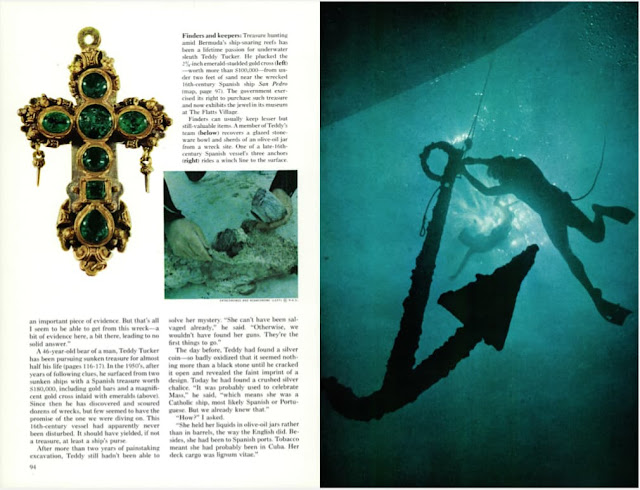 |
| Benchley describes Teddy Tucker's discovery of a "black stone" (left), while a backlit couple dive a 16th century wreck (right) (Source National Geographic) |
Comparing July 1971 National Geographic with the first 10 minutes of The Deep:
 |
| (Source National Geographic (left) and Sony Pictures (right)) |
 |
| (Source National Geographic (left) and Sony Pictures (right)) |
 |
| (Source National Geographic (left) and Sony Pictures (right)) |
The Tucker Cross, which appears on the National Geographic page facing the couple backlit by the sun (below left), makes a cameo later in The Deep when a version is discovered by Gail (below right).
 |
| (Source National Geographic (left) and Sony Pictures (right)) |
By the time Peter Benchley published Shark Trouble in 2002, he had worked with David Doubilet for more than twenty years.
The week before the movie was released Kenneth Turan, writing for the Washington Post, discussed how The Deep was making "movie history" with its print advertising. His story, "An Ad Plunge into The Deep", is noteworthy because it corroborates Barbara Thomas' interview with Peter Yates the following week. Yates disclosed how photos were varied for each magazine but Turan's article showed the actual pictures including the controversial one (below far right) that Bisset had not approved.
 |
| (Source Washington Post) |
 |
| Print advertising as it appeared in Playboy and Penthouse (Source Sony Pictures) (Photographer possibly David Doubilet) |
Turan revealed that 10% of The Deep's print advertising budget focussed upon 5 potential audience categories; "Mr. and Mrs. Front Porch America", "Love-Struck teens", "Underwater Freaks", "Romantic Women" and "Lusty Men". The photo Bisset had not approved, reportedly considered "excitement and sex appeal" by publicity staff, targeted "Lusty Men" with a 3 page foldout in Playboy and Penthouse that decades later is still traded online.
 |
| The 3 page foldout that appeared in June 1977 Playboy. |
When Barbara Thomas' story broke the day after the film's release it was clear the photo had surpassed the "Lusty Men" market and become viral. Thomas wrote, "Yates and most everyone else is talking about the magazine ads from "The Deep," showing voluptuous Jacqueline Bisset swimming about in a clingy wet t-shirt. Publicity increased when she complained about the picture and the photo and comment ended up in Newsweek." Newsweek was one of The Deep's own promotional partners whose coverage of the film began at production and continued through release. Recalling the controversy in 2021, Bisset revealed, “I tried to get the thing stopped; I tried to get an injunction on them,” (Gostin, 2021).
 |
| Newsweek revealed in The Deep's own promotional literature. |
The 11 July 1977 Newsweek gave one line to the film's "technical triumphs" but filled newsstands with pages about "A Beauty Named Bisset" wearing a "wet T shirt that creates a nakedness beyond nudity". Thomas continued, "At her request, Columbia Pictures "banned" the photos in the ads, said Yates, but all the chatter has made the ads "collector's items."" (The Atlanta Journal and Constitution, 1977).
 |
| "But the film's greatest triumph is Bisset's beauty ..." (Source Newsweek 11 July 1977) |
The Deep reportedly "cost $8.5 million to make, an additional $8.5 million to advertise, and brought the studio $31 million in film rentals" (New York Times, 1978). Bisset's photo helped recover almost the entire production budget within three days of opening.
 |
| (Source Paper Nostalgia and eBay) |
Nick Nolte also recalled technical challenges but singularly credits Jacqueline Bisset for making the film a success. "... we can thank Jackie. Her T-shirt clings to her like a second skin as she climbs out of the water. It was the talk of the movie trade for a long while ..." (Nolte, 2019).
When Piers Morgan raised the issue in 2014 Bisset elegantly laughed it off and over the years she appears happy to autograph copies of the photo which has become collectable.
 |
| (Source Unknown possibly David Doubilet) |
The tradition of sensual art featuring women in seemingly wet clothing dates back centuries, with a legendary example being the Aphrodite statue created by master artist Callimachus over two millennia ago. This iconic piece set the precedent for countless works to come, cementing the enduring allure of an enigmatic female form.
 |
| Venus Genetrix at the Getty Villa, Malibu (Source Getty) |
Aphrodite (Venus Genetrix in Roman copies) appears as if wearing sheer wet drapery, one breast covered the other exposed. Her garment appears to have been submerged and is reminiscent of Nick Nolte’s description of Bisset ... “Her T-shirt clings to her like a second skin as she climbs out of the water”. Like Aphrodite, Bisset hovers contrapposto with her left leg forward and her right slightly back.
 |
| Bisset pose emulates Venus Genetrix left leg forward and right leg slightly back (Source Getty (left) and Sony Pictures). |
In Greek mythology, the legendary hero Heracles was accompanied by the handsome Hylas , whose beauty captured the hearts of the alluring Sea Nymphs. This timeless tale of beauty and temptation has been depicted in art for centuries, particularly in paintings of the 19th and 20th centuries. These mysterious creatures of the sea, Sea Nymphs, also known as Nereids and Goddesses of the Sea, were depicted as stunning maidens draped in white, entranced by the charm of Hylas. According to the psychology of colour in film white symbolises love, reverence, purity, simplicity, and peace.
 |
| (Source Sony Pictures) |
Bisset, as Gail Berke, wears white throughout the film’s first act until the violation implied in the voodoo scene.
 |
| (Source Sony Pictures) |
The ancient Greeks also believed that a man who sees a Nymph becomes possessed by her. Such was the fate of Hylas when Dryope reached through the surface and pulled him to her. But it wasn't just myth that lured men to the depths as Nick Nolte remembered Teddy Tucker regaling his own brush with the dangers of nitrogen narcosis, aka the 'Rapture of the Deep'. Far beneath the waves Tucker once hallucinated the most beautiful girl he'd ever seen and who like Dryope lured him to follow.
 |
| (Source Daily News 10 October 1976) |
The ancients transitioned Nereids from an oral tradition into fresco and marble, making their stories a visual media for the first time. In the second millennium AD, painters brought the same myth to life using canvas and oil. At the dawn of the third millennium, above the wreck of RMS Rhone, David Doubilet made underwater history powerfully transforming Jacqueline Bisset’s Gail Berke, into a ‘rapture of The Deep’, a mesmerising still photo of a motion picture character become Sea Goddess, hovering beyond our grasp only a few feet away.
The Bisset photo overshadowed the success The Deep achieved as possibly the first motion picture to successfully cross-promote through low cost merchandising deals. Mako Boats, the manufacturer of Sunkiss, the small boat Bisset and Nolte climbed aboard, created a display at the 1977 New York Boat Show that included a 4 minute looping trailer of The Deep seen by 700,000 visitors. Mako also sent a brochure promoting the film to 500,000 dealers, customers and boating fans.
Regardless, the film's technical triumphs and savvy cross promotion were eclipsed by Doubilet's photo which converted a potential audience into box office sales.
So, whatever happened to Sunkiss, the dive boat where Jacqueline Bisset created film marketing history?
 |
| Sunkiss by another name in Bermuda, 2019 (Source boattrader.bm). |
In 2019, a Bermuda seller advertised (formerly at boattrader.bm) one of two Mako's purportedly brought to Bermuda and used in this scene. Described as "a piece of Bermudian history", the vessel's real name ...
Boobie Trap.
Were you there when The Deep was being filmed? Share your story of the The Deep filming locations in the comments below.
thedeepfilminglocations(at)gmail.com
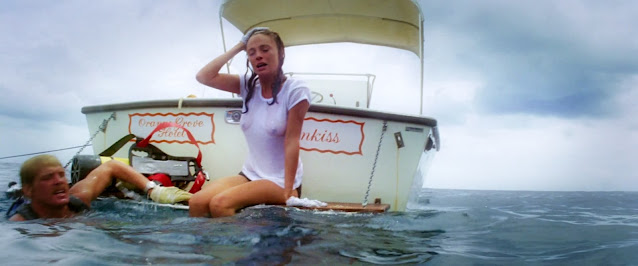



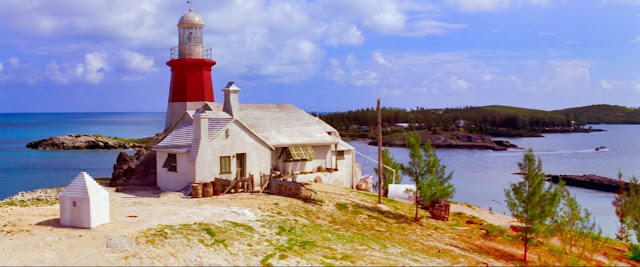

Comments
Post a Comment